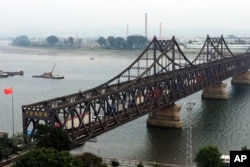U.S. President Donald Trump’s sudden decision to meet with North Korean leader Kim Jong Un, without first working out the framework of a nuclear deal, could produce a historic agreement, but it would come at the beginning of a long negotiation process.
Kim’s willingness to talk about ending his country’s nuclear weapons program was conveyed to South Korean national security chief Chung Eui-yong, who met recently with the North Korean leader in Pyongyang. Chung later told President Trump that Kim “said he is committed to denuclearization,” when he traveled to Washington to brief White House security officials.
Kim’s denuclearization commitment has become the basis for the expected summits between Kim and South Korean President Moon Jae-in to be held in April, and with U.S. President Donald Trump in May.
However the leadership in Pyongyang uses a term for denuclearization that has multiple meanings.
“They translate shutdown, and freeze, and also suspension, and shielding, and also disabling into the same word in Korean, ‘godon joongdan,’” said North Korea analyst Han Young-sup with the Korea National Defense University, during a conference in Seoul on Wednesday about the North’s nuclear program.
High risk
There is a significant risk that President Trump’s unorthodox approach to diplomacy, in agreeing to a summit before any terms, progress or outcomes are set, could fail to produce a complete, verifiable and irreversible agreement to dismantle North Korea’s nuclear weapons program.
Trump himself has said he may quickly walk away if there is no prospect for denuclearization progress, or he might “sit down and make the greatest deal for the world.”
Many suspect that Kim will only agree to freeze or marginally reduce his nuclear and missile arsenal for relief from harsh sanctions that have been imposed in response to the North’s continued testing of nuclear weapons and ballistic missiles.
North Korea in the past also demanded the withdrawal of U.S. forces in Korea as a condition to give up its nuclear deterrent. The U.S. is not likely to agree to either scenario.
Pyongyang’s efforts in the last year to develop a nuclear-armed missile that can strike the U.S. mainland had greatly intensified tensions the region.
The Trump administration led international efforts to ban billions of dollars of North Korean exports including coal, cheap clothing, and seafood, and warned that it would take military action, if needed, to end the nuclear threat.
Supreme mandate
North Korea created an opening for diplomacy by suspending further provocative tests, at least while talks are underway, agreeing to engage with Washington and Seoul, and by participating in the recent winter Olympics in the South.
While risky, Trump’s sudden agreement to meet with Kim at this early stage could a produce a mandate from the highest levels that would drive the process forward.
“The commitment to denuclearization from both sides, from top down, then opens up the path towards diplomacy and a path towards the negotiation of those details,” said Jenny Town with the U.S. Korea Institute at the Johns Hopkins School of Advanced International Studies.
North Korea is estimated to have approximately 30 nuclear weapons, hundreds of medium and long-range missiles, and is continuing to produce fissile material at both its nuclear reactor in Yongbyong and in hidden uranium enrichment facilities.
It would likely take years to negotiate verification details, access for international inspectors, and to complete the dismantlement process.
Concessions
Even though the U.S. insists there will be no concessions until concrete denuclearization measures are taken, North Korea will surely want something in return for its continued cooperation.
South Korea will try to facilitate a nuclear deal during its summit with the North, and could offer an economic incentive by seeking an exemption from sanctions to reopen the jointly run Kaesong Industrial Complex.
“Sanctions or the loosening of sanctions is what we declare them to be. I mean it’s not a rigorous process where you have to go through a court system to decide that a sanction is no longer going to be imposed,” said Bill McKinney, who is also an analyst with the U.S. Korea Institute at the Johns Hopkins School of Advanced International Studies.
Officials in Seoul have consistently linked the prospect of increased inter-Korean economic cooperation with “substantial” denuclearization progress and with the close coordination of the international community.
Lee Yoon-jee in Seoul contributed to this report.











